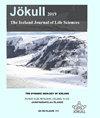Geomorphologic evidence of jökulhlaups along the Hvítá River, southwestern Iceland
IF 0.3
4区 地球科学
Q4 GEOSCIENCES, MULTIDISCIPLINARY
引用次数: 1
Abstract
Glacial outburst floods (jökulhlaups) have been a significant driver of landscape evolution, environmental change, and geohazards throughout the Quaternary. Iceland experiences more frequent jökulhlaups than nearly anywhere else on Earth, though most research focuses on subglacial volcanogenic floods that drain across outwash plains. Abundant geomorphologic evidence exists for largescale jökulhlaups that drained along the modern-day course of the Hvítá River in southwestern Iceland during early Holocene deglaciation, originating from ice-dammed Glacial Lake Kjölur; yet only one previous publication has investigated these events. This study uses a combination of field mapping and remote sensing to identify new jökulhlaup geomorphologic evidence along the Hvítá River, including erosional landforms such as scoured bedrock, anastomosing channel networks, cataracts, and canyons, and depositional features such as boulder bars and channel infill. We synthesize new findings with previously reported work to: 1) present an updated geomorphologic map of Hvítá jökulhlaup evidence; 2) reconstruct flood drainage routes, landscape impact, hydrology, and relative chronology; and 3) hypothesize scenarios of ice margin position and glacial lake evolution. Interpreting flood landform assemblages reveals a more extensive geomorphologic record than previously reported, with a complex drainage pattern along four separate routes from two potentially different sources. Reconstructed peak flow discharges span four orders of magnitude from 10**2 to 10**5 m3s-1. Geomorphologic and paleohydraulic results introduce four hypothesized drainage scenarios, though absolute geochronology is necessary to determine whether multiple floods drained along each route. The Hvítá jökulhlaups yield insight into the timing and dynamics of the final phase of Icelandic Ice Sheet decay, advancing understanding of Iceland’s Pleistocene–Holocene transition, demonstrating the importance of high magnitude, low frequency floods in landscape evolution, and serving as an analogue to ice and meltwater response to past, present, and future climate warming in glaciated regions worldwide.冰岛西南部Hvítá河沿岸jökulhlaups的地貌证据
冰川溃决洪水(jökulhlaups)是整个第四纪景观演变、环境变化和地质灾害的重要驱动力。冰岛经历的jökulhlaups比地球上几乎任何其他地方都要频繁,尽管大多数研究都集中在冰川下的火山洪水上,这些洪水流经冲积平原。大量的地形学证据表明,全新世早期冰岛西南部Hvítá河的现代河道中存在大规模的jökulhlaups,起源于冰坝冰湖Kjölur;然而,此前只有一份出版物对这些事件进行了调查。本研究利用野外测绘和遥感相结合的方法,确定了Hvítá河沿岸新的jökulhlaup地貌证据,包括冲刷基岩、吻合河道网络、瀑布和峡谷等侵蚀地貌,以及巨石坝和河道填充物等沉积特征。我们将新发现与先前报道的工作综合起来:1)提出了Hvítá jökulhlaup证据的更新地貌图;2)重建洪水排水路线、景观影响、水文和相关年代学;3)假设冰缘位置和冰湖演化的情景。对洪水地貌组合的解释揭示了比以前报道的更广泛的地貌记录,其中包括来自两个可能不同来源的四条不同路线的复杂排水模式。重建的峰值流量跨度为10**2 ~ 10**5 m3 -1 4个数量级。地貌学和古水力学结果引入了四种假设的排水情景,但绝对地质年代学需要确定每条路线上是否有多次洪水排水。Hvítá jökulhlaups可以深入了解冰岛冰盖衰退最后阶段的时间和动态,促进对冰岛更新世-全新世过渡的理解,展示了高强度、低频率洪水在景观演变中的重要性,并可以作为全球冰川地区过去、现在和未来气候变暖的冰和融水响应的模拟。
本文章由计算机程序翻译,如有差异,请以英文原文为准。
求助全文
约1分钟内获得全文
求助全文
来源期刊

Jokull
地学-地球科学综合
自引率
22.20%
发文量
1
审稿时长
1 months
期刊介绍:
Jökull publishes research papers, notes and review articles concerning all aspects of the Earth Sciences. The
journal is primarily aimed at being an international forum
for geoscience research in Iceland. Specific areas of coverage include glaciology, glacial geology, physical geography,
general geology, petrology, volcanology, geothermal research, geophysics, meteorology, hydrology and oceanography. Jökull also publishes research notes and reports from
glacier expeditions, book reviews, and material of interest to
the members of the Icelandic Glaciological and Geological
Societies
 求助内容:
求助内容: 应助结果提醒方式:
应助结果提醒方式:


